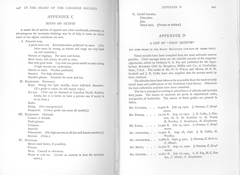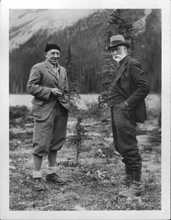After years of humdrum life in the east, the assembly of mountains, lifting their heads serenely among drifting clouds, give one a poignant feeling, of the difference between man's world and God's. Here was purity and measureless peace. Here one might think high thoughts.
The Canadian Rockies: New & Old Trails, (Toronto: Henry Frowde, 1911), p. 23
In the late nineteenth and early twentieth centuries, mountain exploration and climbing were rigorous and often dangerous activities. Mountains were a source of fear, partly because of superstition but mainly because little was known about mountain weather prediction and avalanche conditions.
Climbers would undertake long and expensive journeys to the foot of the mountains (there were no roads and few railway lines). Expeditions would generally begin on pack pony. Trails would be cut through swampy, mosquito- infested bogs known as "muskegs." Climbing equipment was basic, consisting of little more than rope, ice- axes, a knapsack, and stout shoes.
With popularization of this "dangerous sport," professional climbing guides and mountain climbing clubs developed in the European Alps, the United States and Canada. Coleman, who had gained mountaineering experience in the Alps in the 1880s, and his brother Lucius (a rancher in Morley, Alberta), were part of the Canadian
alpinist vanguard. Their explorations of the Rockies gave impetus to the sport.



